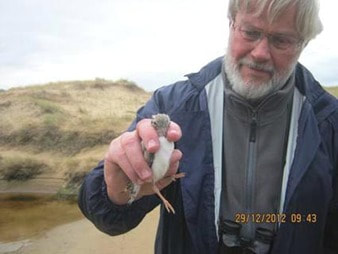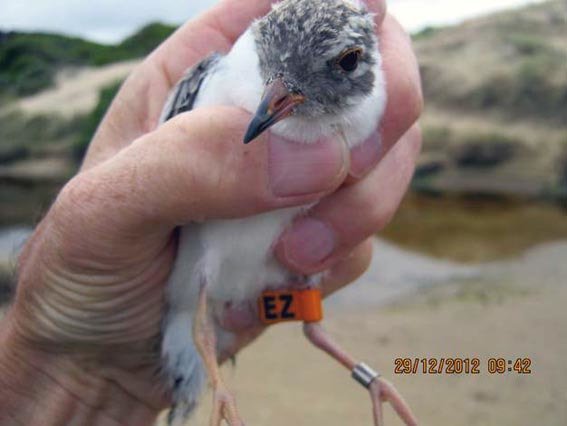After watching a pair of Cape Paterson hooded plovers fail to raise a single chick from four clutches of eggs last summer, Graeme Henry was delighted when two chicks hatched out in early December. He continues the story.
I REMEMBER now: it’s the way they run, and stop, and run, as if they are on wheels, like the clockwork toys I had as a kid.
One chick survives.
A few days after Christmas, a typical Cape Paterson day (windy, some showers), three intrepid hunters (Steve Johnson, Barry Castle and myself), armed with an oversize butterfly net and a tool box, set out to catch and band the chick. This is an important ceremony, a bit like a baptism.
After trudging across the sandy wastes, Steve, whose eyes are better than my binoculars, spots the birds: two parents, Uncle Charlie (who always seems to be there) and the chick. Steve, who holds the record over 20 metres of soft sand, chases with the net. The chick heads for the creek. But before it can kamikaze, Steve expertly wields the net.
The chick is weighed, measured meticulously from beak to toenail, all details carefully recorded by Barry. It receives an aluminium band with its own unique number, which could only be read if it is found dead somewhere. And a plastic bright orange band with the letters EZ, which can be read with good binoculars or by Steve.
Easy does it. The chick is banded and released. Pictures by Steve JohnsonI am proud to be granted the honour of releasing it, but, traumatised, it doesn’t want to move till I give it a gentle shove. I’m calling it “it” because you can’t tell their sex unless you see them at it.
EZ. Life wasn’t meant to be easy, someone once said (G’day, Malcolm, and I’m now quite glad I didn’t run you over outside the Peterborough Store in … 1979, I think).
Let’s hope EZ proves him wrong.
One chick survives.
A few days after Christmas, a typical Cape Paterson day (windy, some showers), three intrepid hunters (Steve Johnson, Barry Castle and myself), armed with an oversize butterfly net and a tool box, set out to catch and band the chick. This is an important ceremony, a bit like a baptism.
After trudging across the sandy wastes, Steve, whose eyes are better than my binoculars, spots the birds: two parents, Uncle Charlie (who always seems to be there) and the chick. Steve, who holds the record over 20 metres of soft sand, chases with the net. The chick heads for the creek. But before it can kamikaze, Steve expertly wields the net.
The chick is weighed, measured meticulously from beak to toenail, all details carefully recorded by Barry. It receives an aluminium band with its own unique number, which could only be read if it is found dead somewhere. And a plastic bright orange band with the letters EZ, which can be read with good binoculars or by Steve.
Easy does it. The chick is banded and released. Pictures by Steve JohnsonI am proud to be granted the honour of releasing it, but, traumatised, it doesn’t want to move till I give it a gentle shove. I’m calling it “it” because you can’t tell their sex unless you see them at it.
EZ. Life wasn’t meant to be easy, someone once said (G’day, Malcolm, and I’m now quite glad I didn’t run you over outside the Peterborough Store in … 1979, I think).
Let’s hope EZ proves him wrong.

